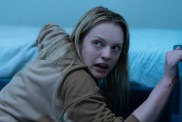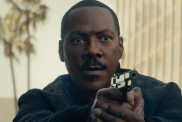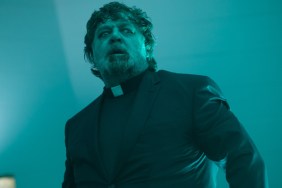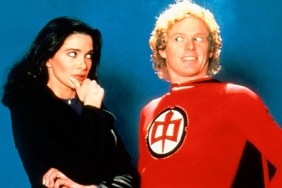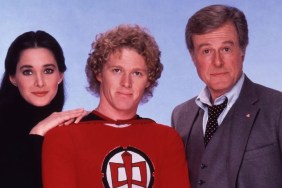Ryan analyzes this lupine terror film

No one trick or treats on the last day of school, no one carves jack o’ lanterns on July 4th, or goes on haunted hayrides in August.
When it comes to beloved macabre traditions, the fall is the season that gets all the attention. Thanks to the celebration of Halloween, the autumn months have always been indelibly associated with all things frightful. Summer, on the other hand, is ostensibly all that horror isn’t about â a golden time of warm weather, trips to the beach, fireworks, road trips and family picnics.
For those movie buffs that prefer the inside of their neighborhood cinemas (or, for some, the nighttime chill of drive-in theaters) to the blistering heat, however, the summer is the real witching season. Some believe that horror vacations in summer, waiting for fall to arrive, but box office history tells a different story.
Starting in 1975 when Jaws invented the modern blockbuster by teaching a generation to be afraid of the ocean, summer has been the best time of year to be scared. The fall can keep Halloween. It can keep the costumes, the candy, the Great Pumpkin, all of it â because summer has always had the better movies.

It’s easy to see how Wolfen can be misidentified as a werewolf film. The Orion Pictures and Warner Bros. release arrived a few months after flesh bubbled and peeled away to reveal Rick Bottin’s lycanthropes in The Howling and it opened in theaters a month prior to John Landis’ An American Werewolf in London. Yes, you could say if 1985 catered to the undead in all of their guises, you might consider 1981 the year that tried to strike fear into audiences with myriad lupine horrors. But even though Wolfen wields a moniker suggesting man beasts on the rampage, it’s not that at all. Hell, it’s not even a “shape-shifter” story, although that element serves as a red herring in this murder mystery.
Instead, Wolfen is an old world versus new world cautionary tale that is just as potent today – and somewhat foretelling – as it was in ’81 when placed alongside today’s post-9/11 context and increasing far-reaching environmental anxieties. You just have to snip around all of the fur and look beyond the gloriously dismembered limbs on display to see the heart pulsing at Wolfen‘s core.
On the surface, Michael Wadleigh might not have been an obvious choice to direct this adaptation of Whitley Strieber’s 1978 novel. Also a cinematographer, Wadleigh was on the frontlines of change in America when he helmed Woodstock in 1970; prior to that, he shot David Weiss’ documentary No Vietnamese Ever Called Me Nigger, about a 1967 anti-war march that began in Harlem and ended at the United Nations. Examining the themes of Wolfen, Wadleigh turned out to be a perfect choice for the film. What he delivered is slightly uneven as far as scares are concerned, still, it’s an engaging tapestry of conflict concerning archaic legends and an encroaching contemporary society.

Wolfen‘s chain of events are set off when Christopher van der Veer, a wealthy developer (primed for the Presidency, as we’re informed), and his coke-binging wife are killed in Manhattan’s Battery Park, regardless of the security firm they’ve hired to watch and protect their every move. The lead-up to the attack is graceful, standing chimes and the creak of the wind mill cradle the scene in tranquility before the bloodshed begins. Wadleigh utilizes a thermographic POV (predating Predator) for his unseen assailants, a nifty effect then and a prehistoric gimmick by today’s standards, but it’s his way of telling viewers from the outset that the danger here is supernatural regardless of the various plausible suspects the story posits.
This, of course, is merely a visual device to gussy up a police procedural narrative that doesn’t call upon that many special effects, save for assorted body parts and cadavers, because there is no big “transformation sequence” here like Wolfen‘s cousins American Werewolf and Howling. Although it is interesting to see Wadleigh decidedly using shots of a full moon (which at one point bleeds to red), an archetype of the werewolf genre, perhaps at the studio’s insistence.
The investigation angle of the story begins shortly after the aforementioned high society couple are turned into mince meat. (Mind you, this happens under the gaze of the Statue of the Liberty standing just across the water from the park – a minute slice of symbolism in Wadleigh’s larger picture.) Enter Dewey Wilson, Albert Finney’s “very weird and very strange” New York City detective, who is pulled from his Sunday morning jog (which he follows with coffee and donuts) and assigned to handle the Van der Veer murders.

Throughout the film, Wadleigh represents the murder mystery on two fronts. There’s Dewey – a crusty, albeit witty, character finely portrayed by Finney – the embodiment of old school. In his office hangs a sign that reads, “God, guns and guts made America. I say we keep all three.” just to give you a sense of his character. He does the leg work. Follows the leads. Goes with his gut and does a lot of thinking alone to piece all of the clues together. Elsewhere, however, the investigation is also being handled by Executive Surveillance Systems, those responsible for following Van der Veer before his death. They’ve got the latest in high-tech equipment and from their dark cocoon of technology, they’re determined to root out the supposed “terrorists” (as Van der Veer’s presence was felt across many third world countries, ESS supposes he had many enemies) responsible for the killings.
Both Dewey and ESS, separately, find the satisfying answers and suspects they are looking for. At the slightest hint of terrorism (i.e. Van der Veer’s murder) ESS steps up and calls for swift action. They wrangle potential homeland terrorists for questioning (Wadleigh cameos as one suspect) and when they get enough evidence – however questionable it might be – they move in for the kill and make their arrests during a violent shootout, all of it playing out on ESS monitors. Does any of this sound vaguely familiar to U.S. events of the last decade?
To further draw Wolfen‘s post-9/11 parallels, Dewey even says, “I don’t think this has anything to do with terrorism.” When he is queried what is behind it, his answer is, “Paranoia.” The man knows what he’s talking about. Of course, in Wolfen, ESS is wrong and there’s only one truth, and it’s thanks to Dewey’s determination and his own inevitable acceptance to look beyond the norm that we learn who the killers are.

Wadleigh throws a number of red herrings at his viewer. But it’s not until Dewey’s investigation expands to multiple disappearances and murders, in which body parts are being eaten (usually from vagrants), that he looks to Native American Eddie Holt (Edward James Olmos), an ex-con, and his group of friends. Here is where Wadleigh spends his time exploring the myth of shape-shifting and it makes for an engaging subplot – because the viewer’s imagination begins to wander with various outcomes – yet he dashes it all in a telling scene during which Dewey tracks Holt to a beach. The latter strips down and proceeds to run about like a wolf, howling at the moon before giving Dewey a good scare and reminding him, “I told you, man, it’s all in the head.” referring, of course, to the act of shape-shifting.
This brush with Native American folklore isn’t far from what Dewey is searching for as it turns out the killings are being carried out by ancient spirits taking the guises of wolves. Like the Native Americans before them, these “hunters” are being pushed out of their land (here, it’s the slums where they feed on American “trash”) and they are merely protecting their territory. (They “want New York back,” as Eddie says.) However, they’re highly intelligent as well, so if they even get the sense that they are being identified, they’ll track you down and kill you. Naturally, Dewey becomes a target, and so do his pals on the case, Rebecca (Diana Venora), Whittington (Gregory Hines, adding a bit of levity to every scene) and the Central Park Zoo’s Ferguson (the always passionate Tom Noonan).
It’s in the moments where Dewey and company are thrust into danger (or supposed danger) that Wadleigh stumbles. His scenes of intensity either start strong and end on a weak note or vice versa. Case in point of the latter: Dewey and Rebecca walk through the detritus of a neighborhood being demolished. Their journey takes them into a dilapidated church where Dewey senses something is amiss. He hauls Rebecca down the stairs and they run off. Wadleigh’s camera, however, lingers on the shadows where two red eyes peer out. Chilling stuff that he oddly counterbalances with a time-padding sequence later on in which Rebecca is frightened by a cat in her apartment.

Regardless, Wadleigh’s mishandling of the frights is no reason to dismiss Wolfen. In Wadleigh’s world, the past is something to be feared and never forgotten, he also makes room for reflection on gentrification, overpopulation and genocide. Whoa, momma, right? A lot more than anyone might be in for when sitting down to watch a film called Wolfen. But it’s not all heavy-handed. For every calculated shot – like that of a Native American bar patron sharing the screen with an American flag in the foreground – there is Finney, Hines and Noonan each bringing some humor to the table. There’s also the awesome click-clacking James Horner’s score (which he’d rip off himself for Star Trek II: The Wrath of Khan and Aliens) consistently telling you with its aggressive horns that this is a scary movie. But a scary movie with something to say, as Dewey’s final statement reminds us: “In arrogance, man knows nothing of what exists. There exists on Earth such as we dare not imagine. Life is as certain as our death. Life that will prey on us as we prey on this Earth.”
Wolfen, more than a werewolf film, yes? And perhaps more than what audiences, seeking summer time escapist fare in 1981, anticipated . Wolfen proved to be Wadleigh’s first and last fictional feature film. He reportedly was unpleased with the final cut. A shame as, with more experience, I think he would have had a lot more to offer the horror genre.
Click here for Jeff’s thoughts on 1981’s Deadly Blessing!
Graduation Day (May 1st)
Happy Birthday to Me (May 15th)
Hell Night (August 7th)
Deadly Blessing (August 14th)
An American Werewolf in London (August 21st)
The Amityville Horror (Jeff Allard)
Phantasm (Ryan Turek)
Friday the 13th (Jeff Allard)






Source: Ryan Turek, Managing Editor
